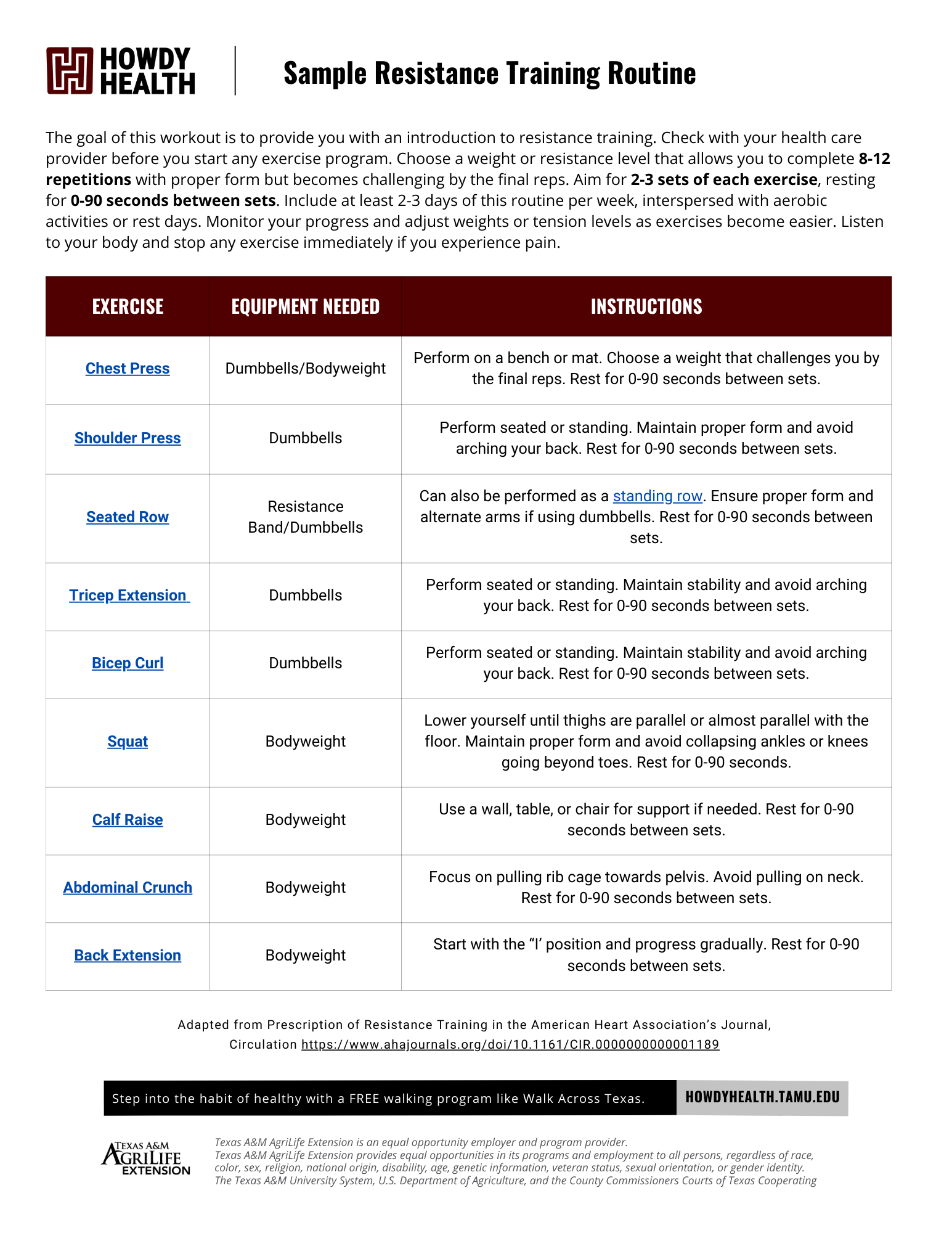The Physical Activity Guidelines for Americans recommend 150 minutes a week of moderate-intensity aerobic activity, such as walking. They also recommend at least 2 days a week of muscle-strengthening activity that make your muscles work harder.1
Resistance training, often referred to as strength training, encompasses any exercise that causes your muscles to work against an outside force (external resistance). The outside force can come from:
- Free weights (dumbbells, barbells, kettlebells, medicine balls, or sandbags)
- Weight machines (those found in gyms, using stacked weights on a cable)
- Cable and pulley suspension equipment
- Resistance bands or tubes
- Body weight (push-ups, pull-ups, planks, squats, or lunges).
Getting Started
If you’re new to resistance training, don’t be intimidated. It can feel overwhelming to learn about all the possible equipment and muscle-building exercise options.
Start with no equipment at all – just your body weight. As you progress, add some equipment, like a set of dumbbells or resistance bands, to add variety. You can also use items from around your home, like water bottles or canned goods to act as added weight and not have to budget for anything additional.
If you prefer to start at a gym, contact them and ask for a certified personal trainer to show you around, and explain how to safely and properly use each piece of equipment. Many gyms will offer a free consultation and the trainer can help you set up a resistance training routine to get you started. Don’t hesitate to ask questions at subsequent visits to be sure you’re using the equipment properly and with the best form and tempo to gain benefits.
To learn more about specific muscle-strengthening exercises, take a look at the exercise libraries from the American Council on Exercise and the National Academy of Sports Medicine.
Guidelines: Major Muscle Groups
The Physical Activity Guidelines recommend that when doing muscle-strengthening activities, they should be done at moderate or greater intensity, and they should involve all major muscle groups.1
Major muscle groups include the:
- Legs
- Hips
- Back
- Abdomen
- Chest
- Shoulders
- Arms
You can choose exercises that work one area at a time (e.g., a bicep curl primarily works the biceps in the upper arm) or multiple muscle groups simultaneously (e.g. a push-up works the muscles of the arms, chest, and shoulders). When choosing exercises, it can help to think in terms of three main groups of exercise:
- Upper body: Focus primarily on exercises that work the muscles of the arms, chest, and shoulders.
- Lower body: Focus primarily on exercises that work the muscles of the legs and hips.
- Core: Focus primarily on exercises that work the abdomen and back.
Some people like to focus on upper body exercises one day and lower body another day of the week with some core exercises at each session. Just be sure to work all the major muscle groups at least 2 days a week because these activities provide additional health benefits to aerobic activity alone.1
Benefits: Functional & Performance
“Adults have a real need to maintain resistance training because typically, over the course of adulthood, the amount of muscle decreases while the amount of body fat increases.”2
Progressively strengthening your muscles with resistance training activities can result in a myriad of benefits. Muscle-strengthening activities can help:
- Increase muscle strength, endurance, and power
- Increase bone mineral density and bone strength
- Increase muscle and connective tissue growth and durability
- Increase communication between brain and muscle
- Improve body composition by reducing fat stores, increasing or maintaining muscle mass, and increasing resting metabolic rate
- Improve sports performance
- Improve blood glucose levels and the body’s sensitivity to insulin
- Improve blood pressure
- Improve cardiovascular health
- Improve blood lipids (decrease bad cholesterol, increase good cholesterol, decrease triglycerides)
- Maintain muscle mass during weight loss
- Slow the loss of muscle that comes with aging
- Reduce falls and injuries
- Prevent, reduce risk, or delay onset of functional limitations (such as climbing stairs, carrying groceries, picking up children or grandchildren, etc.)1,2,3,4
According to the American College of Sports Medicine, resistance exercise can help manage and treat many conditions, including arthritis, cancers, cardiovascular disease, dementia, depression, diabetes, fall risk, frailty, high blood pressure, insomnia, low back pain, mental health, movement disorders, obesity, osteoarthritis, osteoporosis, pulmonary vascular disease, and stroke.2
Tips: Reps, Sets, & Tempo
Improvements in (or maintenance of) muscular strength are specific to the muscles you use during activity. So, it’s important to do a variety of muscle-strengthening activities to achieve balanced muscle strength.1
You don’t have to spend hours lifting weights to gain benefits. You can achieve significant improvement in your strength with just 2-3 sessions of 20-30 minutes of resistance training a week.5
Here are some tips to get you started:
- For muscle strengthening exercises, make gradual increases over time in the:
- Amount of weight
- Number of sets
- Number of days per week.
- Choose 8-10 different exercises involving the major muscle groups. Vary these exercises over time. Be sure you’re working all major muscle groups 2x per week.
- Perform 8-12 repetitions of each exercise to the point at which it would be difficult to do another repetition of each exercise.
- Perform 1-3 sets of each exercise.
- Perform exercises 2-3 days per week with 1-3 (but not more than 3) days between resistance training sessions – to allow for appropriate muscle recovery, while facilitating an effective training program.
- Keep an even tempo, lifting weights in a controlled manner (e.g. counting 2 seconds as you pull the weight or resistance up and 2 seconds as you let it down) and focus on using proper form.
- Talk with your doctor, physical therapist, and/or certified professional trainer about how to best meet your fitness goals.1,3,6,7,8
Need some exercise motivation?
Join one of our free programs!
- U. S. Department of Health and Human Services. Physical Activity Guidelines for Americans, 2nd edition. Washington, DC: U.S. Department of Health and Human Services; 2018. https://health.gov/our-work/nutrition-physical-activity/physical-activity-guidelines/current-guidelines
- ACSMS Complete Guide to fitness and health. ACSM_CMS. Accessed April 5, 2024. https://www.acsm.org/education-resources/books/complete-guide-fitness-health.
- Paluch AE, Boyer WR, Franklin BA, et al. Resistance exercise training in individuals with and without cardiovascular disease: 2023 update: A scientific statement from the American Heart Association. Circulation. 2024;149(3). https://www.ahajournals.org/doi/10.1161/CIR.0000000000001189
- Shaw BS, Shaw I, Brown GA. Resistance exercise is medicine: Strength Training in Health Promotion and rehabilitation. International Journal of Therapy and Rehabilitation. 2015;22(8):385-389. doi:10.12968/ijtr.2015.22.8.385
- Mayo Clinic. Strength training: Get stronger, leaner, healthier. April 29, 2023. Accessed April 5, 2024. https://www.mayoclinic.org/healthy-lifestyle/fitness/in-depth/strength-training/art-20046670.
- Fiataraone Singh M, Hackett D, Schoenfeld B, Vincent, Heather K, Wescott W. Wescott, Wayne. Resistance training for health. American College of Sports Medicine; 2019 Accessed April 5, 2024. https://www.acsm.org/docs/default-source/files-for-resource-library/resistance-training-for-health.pdf?sfvrsn=d2441c0_2
- National Strength and Conditioning Association (NSCA). Essentials of Personal Training SE. Determination of resistance training frequency. May 1, 2017. Accessed April 5, 2024. https://www.nsca.com/education/articles/kinetic-select/determination-of-resistance-training-frequency/.
- Mahaffey K. Resistance training exercises & concepts you should use. NASM. Accessed April 5, 2024. https://blog.nasm.org/resistance-training.
- Sutton B. Determining the best rest periods between sets during training. NASM. Accessed April 5, 2024. https://blog.nasm.org/uncategorized/determining-best-rest-periods-resistance-exercise-training-goals.





